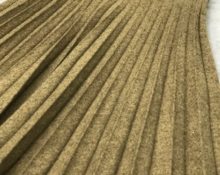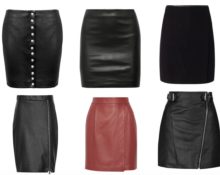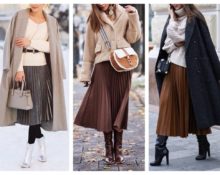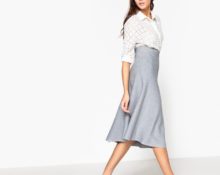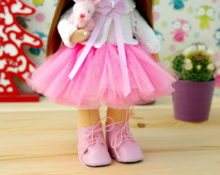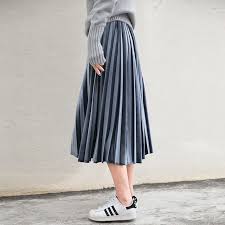 Despite constant changes in fashion trends, pleated skirts remain popular among women of all ages. Even a craftswoman with basic sewing skills can sew such a skirt.
Despite constant changes in fashion trends, pleated skirts remain popular among women of all ages. Even a craftswoman with basic sewing skills can sew such a skirt.
Features of a pleated skirt
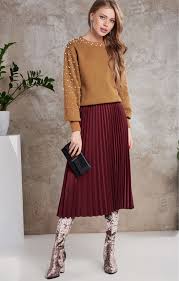 A distinctive feature of a pleated skirt is its conservatism and monotony. It is believed that the folds themselves are already an interesting decorative element. However, lately, interesting options have been appearing with checkered, polka dot, floral and other patterns. Black is rightfully considered a universal color. In this shade, the product, depending on a well-chosen top and shoes, can be worn for almost any occasion. So, with the help of a regular black pleated skirt and a bright, eye-catching blouse, you can create a memorable evening look.
A distinctive feature of a pleated skirt is its conservatism and monotony. It is believed that the folds themselves are already an interesting decorative element. However, lately, interesting options have been appearing with checkered, polka dot, floral and other patterns. Black is rightfully considered a universal color. In this shade, the product, depending on a well-chosen top and shoes, can be worn for almost any occasion. So, with the help of a regular black pleated skirt and a bright, eye-catching blouse, you can create a memorable evening look.
What colors are suitable for such a skirt?
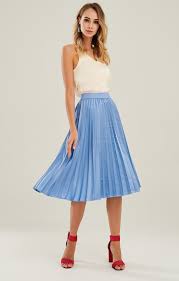 Popular colors are also powdery, gray and milky shades. Blue and mint colors will look good with a black badge.Blue and silver colors can be combined with denim shirts and tops.
Popular colors are also powdery, gray and milky shades. Blue and mint colors will look good with a black badge.Blue and silver colors can be combined with denim shirts and tops.
REFERENCE! Separately, we should highlight the leather pleated skirt in various colors. It is a win-win option and harmonizes with any clothing style.
Making a pattern for a pleated skirt
It is possible to purchase ready-made pleating in fabric stores. If you take a purchased pleated fabric, you will need a standard piece of fabric 150 cm wide and a length equal to the length of the skirt plus a couple of centimeters for processing the top and bottom.
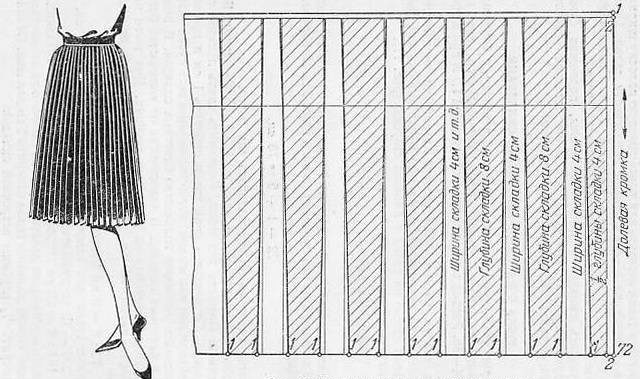
It’s better to make it pleated with your own hands. The material will keep its shape well. First you need to decide on the fullness of the skirt and the width of the folds. The folds can be wide or small. Next you need to calculate the size of the fabric. To do this, you need to increase your hip circumference three times. For example, if the girth is 85 cm, then the width will be 2.6 m. With a regular fabric width of 1.5 m, you need to buy a cut that should be two lengths of the skirt plus about 15 cm for processing seams and cutting out the belt.
To make pleats and sew the product, you need to prepare the following materials and equipment:
 several sheets of thick paper;
several sheets of thick paper;- elastic band for lining the belt;
- thread and needle;
- scissors;
- piece of chalk;
- pins for chopping;
- iron;
- rulers and pencils;
- gauze;
- soap, water and vinegar.
How to sew a long pleated skirt with your own hands: step-by-step guide
There is a very interesting and ancient technique for making folds. Let's look at it in more detail:
 First you need to fold the sheets of whatman paper together and mark the folds along its length.
First you need to fold the sheets of whatman paper together and mark the folds along its length.- Next, we apply a long ruler to the resulting marks and draw them across the paper using scissors. There should be a noticeable mark left by the scissors on the surface.
- We fold the sheets into an accordion and put one inside the other. Iron the resulting structure through gauze. As a result, you should get two blanks with which you can make pleats.
- We place the material between the blanks and secure it with pins so that it is firmly fixed.
- Next, iron the gauze soaked in water and wait for the fabric to dry.
- Then carefully remove the paper sheets and sew the folds with large stitches.
- The fixing solution is made from soap, water and a 9% vinegar solution.
- The resulting solution is soaked into gauze and the product is ironed through it. To achieve a more lasting result, this procedure should be performed several times.
IMPORTANT! To sew such products on sewing machines, it is recommended to purchase a “super stretch” needle. This will allow you to do the necessary processing quickly and efficiently.
One of the most popular are long floor-length pleated skirts. Follow a certain sequence of actions:
 Prepare pleated fabric measuring 1.5 x 1.5 m and the necessary tools.
Prepare pleated fabric measuring 1.5 x 1.5 m and the necessary tools.- Next you should measure your waist circumference. To ensure that the skirt does not lose its shape, it should fit snugly to the waist.
- Then we lay out the piece of material on any flat surface and fold it in half.
- Depending on the desired length of the product, it is necessary to add seam allowances and leave room for the waistband.
- Next, fold the fabric to the width of the waistband and stitch along the entire edge.
- Then we process the bottom of the product. To do this, we make a double hem and sew the seam using a machine.
- We thread an elastic band into the hole for the belt and stitch it on both sides. To prevent the elastic from turning over while wearing, you need to find the middle of the skirt and also sew the elastic in this place.
- We connect the side sections of the skirt, retreating from the edge about 1-1.5 cm.
ATTENTION! For a pleated skirt, it is better to choose synthetic fabrics. The pleating holds up especially well on them. When using thin chiffon, edges and side cuts are processed only using an overlocker.
The pleated skirt has not gone out of fashion for ten years. Despite the apparent complexity of the product, sewing such an outfit with your own hands will not be difficult.


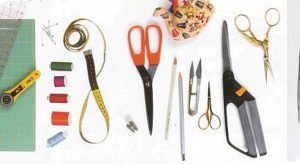 several sheets of thick paper;
several sheets of thick paper;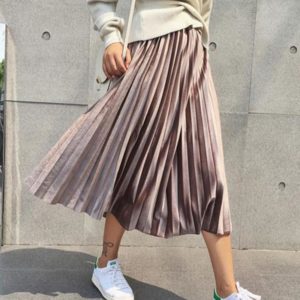 First you need to fold the sheets of whatman paper together and mark the folds along its length.
First you need to fold the sheets of whatman paper together and mark the folds along its length.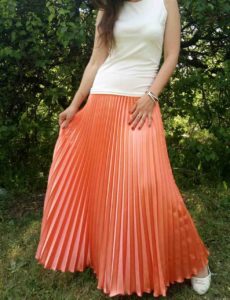 Prepare pleated fabric measuring 1.5 x 1.5 m and the necessary tools.
Prepare pleated fabric measuring 1.5 x 1.5 m and the necessary tools. 0
0